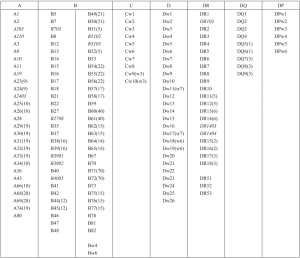Some types of HCoV-specific CD8+ T cells cross-react against SARS-CoV-2
A group from Laboratory for Immunotherapy, RIKEN Center for Integrative Medical Science (IMS), Yokohama, Japan, has reported that some types of HCoV-specific CD8+ T cells may be cross-reacting against SARS-CoV-2.
https://www.ncbi.nlm.nih.gov/pmc/articles/PMC8640030/
Recently, the relationship between Human Leukocyte Antigens (HLA alleles) and COVID-19 is attracting attentions.
Authors assessed the interaction between HLA-A*24:02, as one of the major HLAs, and CD8+ T cells cross-reactive for SARS-CoV-2. In-vitro expansion assays can be used to detect pre-existing CD8+ T cells against cancer or cross-reactive CD8+ T cells to SARS-CoV-2.
 cited from https://www.jstage.jst.go.jp/article/mhc/23/2/23_115/_pdf/-char/ja
cited from https://www.jstage.jst.go.jp/article/mhc/23/2/23_115/_pdf/-char/ja
PBMCs were cultured in the presence of selected each peptide, and the frequencies of epitope-specific IFN-γ-producing CD8+ T cells were assessed on day 21. Although selected six peptides from SARS-CoV-2 Spike protein were expected to bind to HLA-A*24:02 with high affinity, five of these did not induce a T-cell response, and only Pep#3 (Amino acid sequence = QYIKWPWYI, SARS-CoV-2 Spike position = 1208-1216)-specific CD8+ T cell counts were elevated in cells derived from all unexposed healthy donors (UHDs). Intriguingly, Pep#3 exhibited high sequence homology with other coronaviruses, including four types of seasonal coronaviruses (HCoV). Although all the six peptides of S protein were predicted to exhibit high affinity to HLA-A*24:02, five peptides were not homologous to other seasonal coronaviruses.
These results suggest that HCoV-specific CD8+ T cells may be cross-reacting against SARS-CoV-2, and that pre-existing memory CD8+ T cells may be responsible for the immune response.
To understand why CD8+ T cells exhibit multiple responses to various coronaviruses and the underlying mechanisms, we studied the cross-reactivity of CD8+ T cells at the single TCR level. After restimulation with Pep#3, CD8+ T cells from Pep#3-specific CD8+ T cell lines were isolated by gating CD107a+CD8+ cells and performed single-cell analysis of TCR repertoires. To analyze the clonalities of Pep#3-reactive CD8+ T cells, a total of 227 T cells were screened, and 44 TCR clonotypes were identified from five UHDs and one patient with hematological malignancies (HM). Furthermore, we focused on the dominant TCR types from among the clonotypes and identified four types of TCRα and TCRβ pairs from four donors (three UHDs and one HM). To assess the specificity and functions of cloned TCRs, we transduced the TCRα and TCRβ genes into the SKW3-CD8AB (human T-ALL) cell line and demonstrated their peptide-specific response. Intriguingly, the four types of TCR repertoires varied from each other in their epitope recognition. TCR-T (TCR-T-1) cells from UHD2 responded well to all the epitopes derived from coronaviruses, whereas the TCR-T (TCR-T-2) cells from UHD8 responded only to SARS-CoV-1 and SARS-CoV-2.

